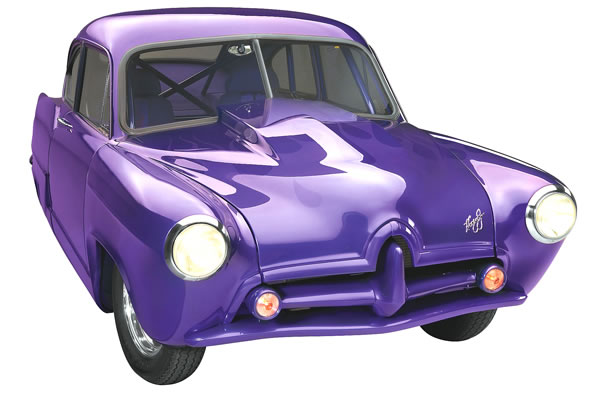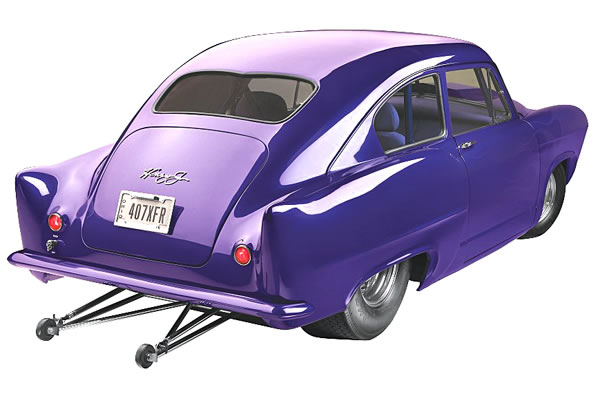This story orignially ran in the Summit Racing catalog and first appeared on the Summit Racing website on June 28, 2006.
Have you ever had that uncanny feeling of someone’s—or something’s—presence? You can almost see it lurking around out of the corner of your eye, but when you turn to confront it, it’s gone.
Bill Brautigam knows all about being weirded out by an unknown something. But instead of running away, he turned that feeling into something cool: this wicked 1951 Henry J.
“I was visiting with a friend one day,” Bill said, “when I saw this odd little car sitting in a field next door. It was an old Henry J. I was intrigued, since it wasn’t the sort of car you see every day. I stood around looking at it, but I never saw the owner. I couldn’t stop thinking about that car. About a year later, I’m out driving around for my job and I saw that very same car again, sitting in a parking lot. Again, I stopped to look at it, but no owner showed up.”
Everywhere he went after that, Bill kept seeing Henry Js. Sometimes he was too busy to stop; other times he’d wait around for the owner to show up, but to no avail. The mystery only fueled his obsession.
“Finally, I saw a flamed front clip in a driveway,” Bill said. ”I stopped and went back, and sure enough, a whole Henry J was back there. I went up to the house, and—at last—I got to talk to the owner. I asked him if the car was for sale and he said it was, but a woman had already made an offer.”
After all this time, Bill felt a bit dejected about being beaten to the punch. But it turned out the mystery woman who bought the Henry J was Bill’s wife, Carrie. She got the car for him as a Christmas present in 1997.
Bill and his buddy, Ron Kintz, who have a long history of building cars together, got right to work on the little Henry J. The cash was already in hand.
“We have always worked on custom cars for other people on the side and use the money from that to bankroll projects like this,” Bill said.
It took the guys six-and-a-half years to finish the car. Rather than go the Gasser route most people go with Henry Js, Bill went low and tubbed. In fact, the outer shell is the only original part of the car Bill retained. He and Ron fabbed the 2 x 3-inch box tube frame, the roll cage, and the floor, then shoved the dash and firewall back 11 inches. The only task handled outside of the Brautigam garage was the upholstery, done by Marilyn at Miracles Upholstery.
Under the hood is a heart of pure Detroit iron—a .030-inch overbored 454 fitted with a GM steel crank, GM rods, and ported and polished oval port iron cylinder heads. A rejetted Holley Dominator on a Strip Dominator intake handles the induction work. The rest of the engine is a virtual who’s-who of hot rod gear: Competition Cams solid camshaft, MSD ignition, ARP fasteners, Summit Racing one-wire alternator, Flex-a-lite electric fan, and Hedman headers. A Turbo 400 transmission sends the power to the Mickey Thompson rubber.
The Henry J has been on the show circuit for a while now, and Bill’s ready to take it off the leash.
“We’re probably gonna hit the strip this year and see what happens,” Bill said. “We might swap in some aluminum heads for that, but either way I think it’s going to surprise a lot of people. We figure it [the engine] makes about 580 horsepower at 6,000 rpm.”
That should be more than enough to haunt a few guys at the track, don’t you think?
FAST SPECS
Chassis
Frame: Custom 2-inch x 3-inch box
Rear Axle: Powdercoated Ford 9-inch with Detroit Locker differential, 4.56-ratio Richmond Gear ring and pinion, Moser 31-spline axles
Rear Suspension: Chris Alston four-link with HAL adjustable coil-over shocks
Front Suspension: Mustang II tubular control arms and HAL adjustable coil-over shocks
Brakes: 4-wheel Wilwood disc brakes
Wheels and Tires: 15 x 3 Bogart wheels (15 x 3 front, 15 x 14 rear), Mickey Thompson Sportsman tires (26 x 7.5-15 front, 31 x 18.5-15 rear)
Chassis Work: Bill Brautigam and Ron Kintz
Engine and Transmission
Type: Chevy 454, bored .030 inches over
Block: GM iron
Reciprocating Assembly: Polished GM steel crank, GM connecting rods; 10.5:1 TRW pistons—assembly is balanced
Camshaft: COMP Cams mechanical cam (310/316 degrees duration, .663-inch/.654-inch lift)
Cylinder Heads: GM iron oval port, ported and polished
Valvetrain: COMP Cams lifters, COMP Cams valve springs and retainers, Manley valves, Crane rocker arms
Induction: Holley Strip Dominator manifold, rejetted 1,050 cfm Holley Dominator
Ignition: MSD distributor, MSD ignition box, MSD coil, MSD ignition wire; Summit one-wire alternator
Exhaust: Hedman headers, 3-inch dual exhaust with Flowmaster mufflers, all ceramic-coated
Transmission: Turbo 400 transmission, 8-inch ATI torque converter (4,500 rpm stall speed)
Other Items: ARP fasteners, polished billet valve covers
Engine Machining: Tim Lysikowski at Racing Products
Body
Modifications: firewall and dash moved back 11 inches, hand-built floor, seams welded shut on front fenders, welded and smoothed quarter panels, smoothed trunk lid, 1967 Camaro rear bumper smoothed and narrowed 1 3/4-inch, rear belly pan
Paint Color: PPG Ultraviolet
Graphics: Pearl ghost flames by Jim Stallard
Body Work: John Cundiff and Lee Knots
Interior
Upholstery: Two-tone purple tweed
Seats: Modified Dodge Neon buckets
Dash: Stock covered with purple tweed, Auto Meter Ultra-Lite gauges
Shifter: B&M Pro Ratchet shifter
Other Items: Flames in door panels and transmission tunnel, trunk covered in tweed
Upholstery Work: Marilyn at Miracles Upholstery
Special Thanks
Carrie Brautigam for buying the car, Ron Kintz, Jim Stallard, and the Kaiser-Frazer Owners Club for locating parts









I’ve just got send this to a very dear and old friend I worked and helped on race day long ago. But first I must tell you I thought you were talking about are 51 Henry j race car or rather Terry Walter’s car back when they still had a C alter he did a 9 second world record its on the books the best time of .my life @ 18 years old I pulled to the start, got him straight bleech the tires, back him up… check the tension on his wheelybars, his shoot and prayed I did it right cause the only steering he had was cutting brakes the first half and that shoot to stop it. Whats Funny, Rat Poison Henry! Everybody loved it